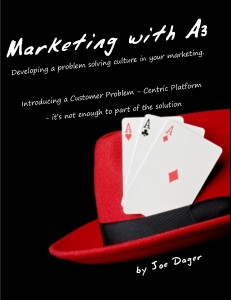Most of our marketing centers on providing a solution for our customers. Everyone has a solution and just about all of them can be made to work for you, sound familiar! But is there anybody out there that can adequately define the problem? The definition of the problem is more important than the solution. We have always heard and most of us believe, “A problem well stated is a problem half-solved.” – Charles Kettering. It really is that simple. We must move our marketing and sales efforts from a solution-centric culture to a problem-centric culture. Sales and Marketing ultimate goal must be to become part of the problem defining culture of a customer or prospect. 
Many organizations define their sales and marketing goals as a way of getting people to take actions to purchase their product or service. They are focused on selling the benefits of their product. Elaborate plans are designed to guide their action for today, tomorrow and in the future. This serves as a platform for their marketing goals. They might even send the goals through the SMART procedure to make sure that they are specific, measurable, achievable, realistic and time-specific. The problem with this is that it is mostly internally focused.
At the present time supply exceeds demand in most markets. Many companies are seeking new markets and extending their reach with a hope of more business. They focus on innovation in their own markets and/or adapting existing products to the new markets. These efforts seldom prove effective for the majority of us. Most of the time someone is already entrenched serving that need, new entrants just seems to drive prices down and reduce market share for all the players.
Marketing needs to be part of the problem solving process of their customers. What if your marketing processes seek to identify problems versus solution? What if you were seen as a diagnostic expert than a solution provider? What if you guaranteed to find the problem and collaborate on the solution? Would you build a more trusting and stronger relationship?
Marketing with A3 is my attempt to improve the problem solving process of Sales and Marketing. Using A3 in the marketing process will provide you a standard method of developing and creating your marketing programs. It will recap the thoughts, efforts, and actions that take place for a particular campaign, such as advertising or public relations or even a launch. An A3 can highlight the value that marketing supplies. You will learn how to format your A3 report in a way that most effectively communicates your story to your team and others.
The A3 tool provides a structure and a template for achieving this. A3 is a one- page document used to capture the dialogue in a problem solving process. Sending your marketing through such a process will enable you to create the clarity to areas such as CRM, Social Media, Joint Ventures, Client Retention, Client Acquisition, and more. It is a tool that can be used both strategically and tactically. It has developed in its own right to become a thinking process.
Stretch your thinking of using an A3. It stimulates thought creativity and when stretched allows many other interactions from others. Marketing with A3 is a new way of thinking; a whole new philosophy. To become truly proficient, you must go through a paradigm shift. You must build a Lean Problem Solving Culture into the way you create your marketing and think of your marketing. You have to move from solution centric to problem centric. You must develop strategies to focus on the right customer conversation – their problem?



